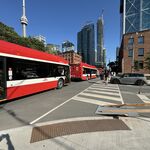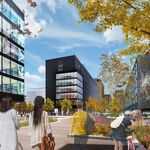k10ery
Senior Member
Salsa, nobody is proposing a bike lane of any kind along the new Gardiner boulevard, are they? So what is the point of your pictures?
Salsa, nobody is proposing a bike lane of any kind along the new Gardiner boulevard, are they? So what is the point of your pictures?
Salsa, nobody is proposing a bike lane of any kind along the new Gardiner boulevard, are they? So what is the point of your pictures?
Where did you stand on the removal of the piece of Gardiner already gone?
So, every other example shows down is down. But this time, because Toronto is unique when it comes to gravity, I'm sure that when I release this cannonball, it will rise. And then other cities will use Toronto's unique gravitational pull to argue down is up, to their detriment. But not Toronto's. Think of the other cities!
That stuff already exists. It's not hard to find auto lobby information and local newspaper reporting stating that the removal of the Embarcadero Freeway and Central Freeway have been disasters for traffic. Go have a quick Google. I haven't see anything about the West Side Highway, but it probably exists too. I know Paris's closure of expressways on the banks of the Seine have been criticized as well.
But keep in mind that the CAA has also published stuff saying that the removal of the Gardiner stump out to Leslie St back in the early 2000s has been a traffic disaster.
In reality, I think consensus is highly unlikely, even 30 years later.
Which is not only the piece that has the least traffic, it's also the only piece that has an 8-lane cross-section rather than a 6-lane one. It's grossly over-designed. And has very little use to anyone commuting downtown - mostly benefiting those who are using the DVP/Gardiner to pass from one part of the city to another.That I didn't have a problem with. It was a short spur east of the highway network. The stretch we are talking about is what connects the main portion of the city's west-east highway to its main north-south route.
Then where is it in this debate? Why are those in favour of demolition able to easily point to countless US cities about how great their teardowns went, and no one us countering with the congestion and economic damage they caused?
Where is all the TTC growth going to come from? If the downtown relief line is not built, then the number of people taking TTC downtown cannot possibly grow that much. The number of people using GO will probably grow a lot more because of the GO electrification plans.
I have a hard time believing that the number of people driving downtown will ever go down. Many people who drive downtown have no choice because they come from an area with poor or no transit service, or they live downtown and work in the suburbs, or they are going through downtown without stopping and would otherwise use the 401. Like it or not, there are lots of people who drive downtown and reducing the capacity of the Gardiner/Lake Shore combination by nearly 50% will cause 24/7 traffic jams. The urban planning department is incompetent and I can't take them very seriously.
Yeah, I can personally attest that even during peak period, I've almost never seen Gardiner east of Jarvis go all the way to congestion collapse. But everytime I head west and pass Jarvis - BAM, I brake for the parking lot of stopped cars, and it's all backed up all the way to Exhibition. But have almost always gone full highway speed no matter which hour of day of any day of the week, during the small section of Gardiner east of Jarvis. Good to see 24 hour YouTube timelapse evidence.Just how busy is the Gardiner Expressway at Jarvis? Not very from the looks of it...
Yeah, I can personally attest that even during peak period, I've almost never seen Gardiner east of Jarvis go all the way to congestion collapse. But everytime I head west and pass Jarvis - BAM, I brake for the parking lot of stopped cars, and it's all backed up all the way to Exhibition. But have almost always gone full highway speed no matter which hour of day of any day of the week, during the small section of Gardiner east of Jarvis. Good to see 24 hour YouTube timelapse evidence.
If *any* section of Gardiner had to be reduced or torn down, it's definitely this small section east of Jarvis, as proposed by the teardown plan. If Remove occurs, it must be done with good due diligence, with concurrent transit expansion going on -- such as GO RER completion and new transit station(s) plus maximally utilizing the possible benefits of boulvard option.




